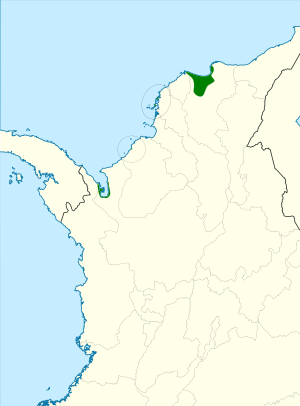Sapphire-bellied hummingbird facts for kids
Quick facts for kids Sapphire-bellied hummingbird |
|
|---|---|
| Conservation status | |
| Scientific classification | |
| Genus: |
Chrysuronia
|
| Species: |
lilliae
|
 |
|
| Synonyms | |
|
|
The sapphire-bellied hummingbird (Chrysuronia lilliae) is a tiny, colorful bird. It is an Endangered species of hummingbird. This means it is at high risk of disappearing forever. It lives only in Colombia.
Contents
About the Sapphire-bellied Hummingbird
Its Name and Family Tree
Scientists often group animals based on their features. The sapphire-bellied hummingbird used to be in different groups, called Lepidopyga and Amazilia.
But new studies looked at the birds' DNA. These studies showed that the old groups were not quite right. So, most scientists moved this hummingbird to a new group: Chrysuronia.
Sometimes, people thought this bird was a type of sapphire-throated hummingbird (C. coeruleogularis). But now, it is seen as its own unique species. It is the only species in its specific group.
What It Looks Like
The sapphire-bellied hummingbird is about 8.9 to 9.4 centimeters (3.5 to 3.7 inches) long. That's about the length of your hand!
Male birds weigh around 4.3 grams (0.15 ounces). Their top beak is black. The bottom beak is pink with a black tip.
Males have a shiny green head, back, and bottom. Their tail is forked, like a "V" shape, and is blue-black. They have a sparkling purple patch on their throat. The rest of their belly is a glittering blue.
Scientists don't know how much female birds weigh. Their feathers are thought to be similar to males. But females likely have more gray on their bellies.
Where It Lives
This special hummingbird lives only in a small area in northern Colombia. It can be found in the mangrove forests of Ciénaga Grande de Santa Marta. This is a wet area near the coast. It also lives in the dry, scrubby lands right next to the mangroves.
How It Behaves
Movement
Scientists are still learning about this hummingbird. They don't know if it moves around much. It might travel short distances during different seasons.
What It Eats
The sapphire-bellied hummingbird loves to drink nectar from flowers. Its favorite flower is from the tea mangrove tree. It also eats from the Erythrina fusca plant in the nearby dry areas. Besides nectar, it also eats small insects.
Life Cycle
Not much is known about how these hummingbirds raise their young. Scientists are still studying their breeding habits.
Sounds It Makes
You can find a few recordings of this hummingbird's sounds online. Scientists describe its calls as "a series of short chatters."
Its Status and Protection
The IUCN (International Union for Conservation of Nature) keeps track of endangered animals. They first said the sapphire-bellied hummingbird was "Critically Endangered." This is the highest risk level.
But in 2021, they changed its status to "Endangered." This means it is still at high risk, but a little less than before.
This hummingbird has a very small area where it can live. This special habitat is still being destroyed. Scientists believe there are only about 285 to 440 adult birds left. Their numbers are going down.
The bird lives in two protected areas. But very few birds have been seen in one of them, Vía Parque Isla de Salamanca. Protecting its home is very important for its survival.
See also
 In Spanish: Lepidopyga lilliae para niños
In Spanish: Lepidopyga lilliae para niños


